A gradual process that brings positive change in human life and behavior is called education. Three different types of education are formal education, informal education, and non-formal education. These three types of education have their characteristics, advantages, and disadvantages. We are not getting the education from the classrooms only. Because we are also getting the education from life experiences too. We have divided our education into different levels. These levels are from preschool to higher education.
What is Education?
The process of facilitating learning or acquiring knowledge or skills is called education. There are different methods to get education. Some essential methods to get education are teaching, training, storytelling, and research. In most cases, we get education under the guidance of educators. Anyhow, some learners can also educate themselves. According to the UN, everyone has the right to get education. We are also observing different movements for education in the world. Particularly, these movements are for evidence-based education. Most of countries have set education compulsory up to a certain age.
When we talk about education, we confuse it with schooling. That’s why most people think that schools and colleges are the only places to get education. They also look for particular people like educators or tutors to get education. Lots of people also think that education is a process to prepare for future living. According to John Dewey, education is not the process to prepare for future living. Its reason is that it is a process of living. Therefore, while getting education, we should try to invite truth and possibilities. We should also try to encourage and give time to discoveries.
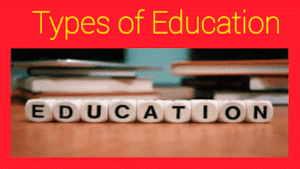
Types Of Education
Nowadays, we are not restricted to get education within the four walls of a school, college or a university. We can get education from various means. That’s why the concept of getting an education has also broadened. The students can get instructions from their experiences. The concept of getting an education is exploring. Therefore, we have divided education into three different categories. The three types of education are explained below;
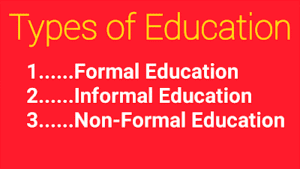
♦Formal education – Structured and symmetric form of learning
♦Informal education – It occurs outside of the asymmetric curriculum
♦Non-Formal education – It occurs outside the formal school system
1. Formal Education
It is a structured and symmetric form of learning. It is one of the most important forms of three types of education. To provide formal education, we require trained teachers. These trained teachers deliver certain standards to the students. Schools, colleges, and universities are providing this education to the students. Certain organizations provide this education in a country. Formal education is classroom-based. Teachers are using textbooks and other materials to deliver education. Before delivering the education, teachers have to get the necessary training. After completing the necessary training, the organizations issue licenses to the teachers for teaching.
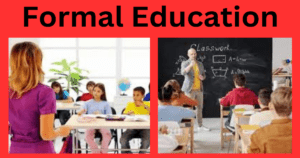
To get this education, students have to show presence in the class. If students fail to show presence in the class, they will not take exams. As a result, they will fail. In the formal education system, teachers also try to involve the parents in the teaching-learning process. They share the progress of the students with their parents. Parents also play their roles in the learning process of their children. In the US, the Department of Education is handling the formal education system in all the states. The Department of Education has also created school districts and school boards. They are managing the formal education system on a smaller scale.
Levels of Formal Education
Different students have different abilities to understand information. Based on their abilities, we divide levels of this education into four categories. Of the three types of education, only this education has different levels of education.
I. Preschool
The preschool level of education is for students of 3 to 6 years. During this period, they learn basic concepts of reading, writing, counting, etc. This level of education is not necessary for all countries. In some countries, the preschool level is separate from the primary school level. On the other hand, in some countries, we have combined it with the primary school level.
II. Primary School
The primary school level is also known as the grade school level. At the primary school level, students get an education during the first few years of their childhood. During the primary school level, students learn the fundamentals of reading, math, and other basic skills.
III. Secondary School
It is also known as the high school level. We divide this level of education into two categories. During the lower secondary level, students get a general knowledge of different subjects. During the upper secondary level, students get education relevant to employment. They can utilize this knowledge to acquire the best job opportunities.
IV. Post-Secondary School
It is the highest level of education. During this level of education, students can get education in specialized fields. All the graduate and undergraduate programs are included in the post-secondary level of education. All the courses of law school, vocational school, and community college are also included at the post-secondary level.
Examples Of Formal Education
There are various examples of this education. Here, we will discuss the most important examples of formal education.
♦Learning something in the classroom is the best example of this education.
♦School certificates are included in this education.
♦College and university degrees are also examples of this education.
♦All the subjects that have proper syllabi are examples of this education.
♦The education that we get by attending an institution is also an example of formal
Characteristics Of Formal Education
Formal education has various characteristics. The main characteristics of formal education are given below;
♦Formal education is purposeful and time-bound. It is syllabus-oriented with specific objectives.
♦ Therefore, the professionals plan deliberately to train the children.
♦ We provide instructions for this education through the proper schooling system. The proper schooling system will educate the people.
♦ The main focus of this education is to prepare a child for practical life. After getting formal education, he can find out the best job opportunity. He can also work for the betterment of his nation.
♦To provide this education, we have to design specific institutions. These specific institutions are in the form of schools, colleges, and universities.
♦There is a definite course of this education. We have to cover this definite course within a definite amount of time.
♦We have to follow a specific process to get a formal education. First, we have to enroll ourselves in schools, colleges, or universities. Secondly, we have to learn a specific course from textbooks or other study material. Thirdly, we have to ensure our presence in the classrooms. At last, we have to pass the exams.
♦We get this education from professional teachers.
♦Formal education is centralized.
♦The teacher has a superior position.
♦The main focus of this education is on the development of the child.
Advantages Of Formal Education
We can’t ignore the importance of formal education. Formal education or a university degree has a unique presence and value in three types of education. The advantages of formal education are given below;
♦Formal education is providing the best opportunities for students to form peer relationships. Its reason is that while getting a formal education, students have to sit together in the company of other students of the same age group.
♦While getting this education, students have to spend plenty of time together. Therefore, they can create a better understanding of each other.
♦In the formal education setting, students have to pass different grades or classes. Therefore, it is providing an opportunity for the students to learn different things in a disciplined way.
♦ It is a continuous process. Therefore, students can develop a habit of how to learn different things continuously.
♦The courses of this education are developed by keeping in mind the growth and development of the students.
♦It provides an opportunity for students to learn from theory. After learning from theory, when they enter into practical life, they perform their tasks with accuracy.
♦While getting this education, students can also develop alternative skills. Schools, colleges, and universities are providing lots of opportunities to students. By acquiring these opportunities, they can take part in the extra-curricular activities. By taking part in the extra-curricular activities, they can enhance their skills.
Disadvantages Of Formal Education
The basis of this education is theoretical work and old methodologies. Therefore, it has lots of disadvantages. The main disadvantages of this education are given below;
♦In the formal education setting, we have to teach bad and good students in the same class. Moreover, some teachers teach good and bad students in the class. Bad students can last some adverse impacts on the learning process of good students.
♦To get a promotion in the next class, students have to wait until the end of the academic session. Instead of learning the course material before the academic session, shiny students can’t get a promotion.
♦The formal education setting is becoming the cause of strains in the minds of the students.
♦All the students have to learn the same course material. If a student is not interested in the specific course material, he will fail and he will not get a promotion for the next class.
♦In this education system, we are also observing the unnatural way of the teaching-learning process.
2. Informal Education
Informal education is an essential type of education in which we get an education outside of the structured curriculum. To get an informal education, students don’t need to follow the structures and levels of formal schools. It is a natural and spontaneous way to get an education. In informal education, students get an education from their experiences. While getting an informal education, students visit places like libraries and museums rather than traditional schools. Informal education allows students to learn important information about their subjects. It is a discussion-based education. It covers the distance between classroom education and life outside the classroom.
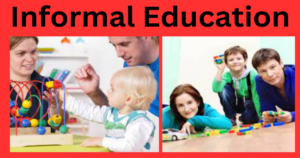
We try to understand the difference between formal and informal education with the help of an example. In the formal education setting, we learn about heat, Physics, and thermodynamics. In informal education, you will learn the same concepts from the experiences. For example, if a person touches a pot handle that doesn’t have a potholder, you will observe that his hand will burn. Here, you will learn that heat from the stove transfers to the pot handle. If we touch the pot handle without a potholder, we may burn our hands. Therefore, we should be very careful while touching the pot handle.
Examples Of Informal Education
There are various examples of informal education. The most important examples of informal education are given below;
♦Teaching some basic concepts to a child at home is an example of informal education.
♦If a child is learning his mother tongue, he is also getting informal education.
♦If you are learning something from life experience, you are getting informal education.
Characteristics Of Informal Education
Formal education starts when someone goes to a school, college, or university. On the other hand, informal education starts from the birth of a child and continues till the death of a person. Informal education has some unique characteristics than the other three types of education.
♦It is not organized just like formal education. It means that there are no specific formulas or guidelines to get informal education.
♦The learners are highly motivated to get informal education. We don’t need to force them to get informal education. For example, if a child learns how to drive a car, he gets the motivation to drive a car. We don’t need to force him to drive the car.
♦In most cases, informal learning is spontaneous. For example, if we are going into the bank to open an account and we learn the whole process of opening an account, it means that we have acquired informal education spontaneously.
♦To get an informal education, we don’t need to follow a specific curriculum. We can get an informal education from our experiences.
♦You don’t require the services of a trained teacher to acquire informal education.
♦We don’t need to enroll in a school, college, or university to get informal education. The whole world is your classroom to get an informal education.
♦We can’t quantify informal learning. Its reason is that after getting the informal education, we don’t need to take exams.
♦Informal education is necessary for the early development of a child.
♦It is also necessary for the lifelong learning of an adult.
Advantages Of Informal Education
To get an informal education, we don’t need to attend regular classes. Informal learning has various advantages.
♦First, while getting an informal education, students don’t have strains on their minds. Its reason is that after getting an informal education, students don’t have to take exams.
♦Second, they don’t have to bother about grades.
♦Third, informal education is offering natural ways of teaching and learning.
♦Fourthly, teachers don’t need to motivate their students to get informal education. They
are self-motivated to get informal education.
♦Fifth, in the informal education setting, students don’t need to depend on rote learning.
Disadvantages Of Informal Education
Learners get informal education outside of schools, colleges, and universities. Therefore, there are also some disadvantages of informal education.
♦Informal education is providing the best opportunities for students to acquire the best quality knowledge. Now, the problem is that informal education can’t give enough confidence to the learners. The learners feel inferior in the group of well-educated people.
♦We are getting an informal education without getting directions from the teachers. Therefore, we can’t get an idea of whether we are learning the right things or the wrong things.
♦We can’t learn those things that we can learn in the company of the same age group fellows.
♦ We can’t instill the ability of discipline in our lives.
♦One can get an informal education individually. Therefore, it is not providing opportunities for learners to create peer relationships.
3. Non-Formal Education
The type of education that occurs outside of the formal school system is non-formal education. The non-formal education is different from the other two types of education. We use various terms for non-formal education. These are community education, adult education, and second-chance education. Government and private organizations take a wide range of initiatives to provide non-formal education in the community. For this reason, these organizations have designed accredited courses for non-formal education. The well-established institutions with little funding are providing non-formal education. The main aspect of non-formal education is to provide education to those children and young adults who can’t get an education in the regular school system.
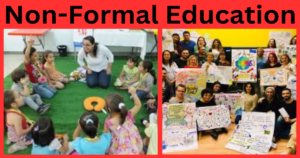
Non-formal education has various objectives. The main objective of non-formal education is to provide functional literacy in the community. With the help of non-formal education, we can also continue the education process for those students who have not completed primary education or who can’t continue formal education. Non-formal education is also helpful for students to improve their basic knowledge and skills. Students can get non-formal education besides formal education. To get non-formal education, students have to follow the validation and accreditation process. Therefore, we can also include non-formal education in our qualifications.
Examples of Non-Formal Education
We design non-formal education courses by keeping in mind the personal needs of the students. The most important examples of non-formal education are given below;
♦The swimming sessions for the toddlers
♦Therefore, the educational courses and programs that we devise for the Boys Scouts and Girls Guide come into non-formal education.
♦The community-based sports programs also come into non-formal education.
♦All sports and fitness programs are also the best examples of non-formal education.
♦The programs and courses that are developed for professional development also come
into non-formal education.
♦Computer and language courses
♦Free online courses
Characteristics Of Non-Formal Education
The main objective of this education is to enhance the skills of children who are not going to school. Therefore, after learning these skills, they can handle various tools and techniques. The most important characteristics of non-formal education are given below;
♦Like formal education, it is well-planned. The only difference between formal and non-formal education is that to get a formal education, you will have to go to the schools. On the other hand, to get non-formal education, you don’t need to go to school.
♦This education system is based on the participatory learning system.
♦It is providing an open-ended education system to the students.
♦To get this education, you don’t need to study structured courses and curricula.
♦To get this education, you will see lots of flexibility in age, time, and curriculum.
♦The students can get this education from both the public and private sectors.
♦Like formal education, students don’t need to take part in regular exams while getting a non-formal education.
♦Most of the non-formal courses are skill-based. Students don’t need to win awards or certificates.
♦This education is providing the best opportunity for self-learning.
Advantages Of Non-Formal Education
If a student gets a non-formal education, he can enjoy lots of benefits. The main advantages of non-formal education are given below;
♦The non-formal education system is providing a chance for the students to earn while learning. Along with learning, students can also become self-dependent and self-independent.
♦To acquire a non-formal education, students have to do hard work. Therefore, non-formal education is instilling habits of hard work in the students.
♦It is the best way for the students to utilize their free time. It means that students can learn any skill along with formal education.
♦Non-formal education is providing the best chance for students to achieve their goals. After acquiring this education, students can also achieve fast-changing goals.
♦It is also providing the best opportunities for the students to cover up their deficiencies. Therefore, after covering up their deficiencies, students can also enjoy a healthy lifestyle.
Disadvantages Of Non-Formal Education
Like other types of education, there are also some disadvantages of non-formal education.
♦No doubt, non-formal education is providing the best opportunities for students to achieve the desired diplomas or degrees. Anyhow, they can’t build the same confidence level just like formal education students.
♦To earn a degree or a diploma, students don’t need to study regularly. They have to study before the exams. Therefore, luck is playing a major role in building the careers of non-formal students.
Suggestions For Bringing Improvements to Education System
It is a fact that knowledge is a power and it comes from three types of education systems. Therefore, we should allocate our resources and efforts to bring improvements to these education systems.
♦First of all, we have to identify flaws in the current education system. After identifying these flaws, we have to set objectives to overcome these flaws in the education system.
♦Secondly, we have to promote project-based learning in schools, colleges, and universities. It will enable the students to deeply understand the topics.
♦Thirdly, we have to introduce modern technology in schools, colleges, and universities. It is the best way to bring transparency and accuracy to our education system. Moreover, it is also a cost-effective way to educate the students.
♦Fourthly, we have to remodel the grading system of our schools, colleges, and universities. After remodeling the grading system, we can prepare a detailed report of the strengths and weaknesses of the students.
♦At last, we have to invest in upgrading the teaching methods. We have to educate the teachers to make emotional and intellectual connections with the students. Moreover, we have to develop some essential qualities of teachers.
Conclusion
Education is necessary to survive in society. We can get an education in various ways. There are three types of education. The education that we are getting from well-established schools, colleges, and universities is formal education. The education that we are getting outside of the four walls of schools, colleges, and universities is informal. We get non-formal education outside of the formal school system. To get a complete idea of the whole education system, we have to look at the characteristics, advantages, and disadvantages of these systems. Therefore, if we want to get success in our life, we have to focus on all three types of education.






Thank you again for all the knowledge you distribute,Good post. I was very interested in the article, it's quite inspiring I should admit. I like visiting you site since I always come across interesting articles like this one.Great Job, I greatly appreciate that.Do Keep sharing! Regards, Sandy Hook Parent